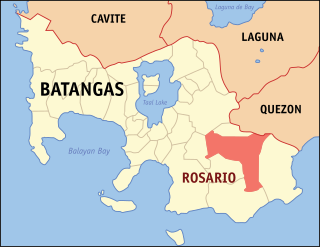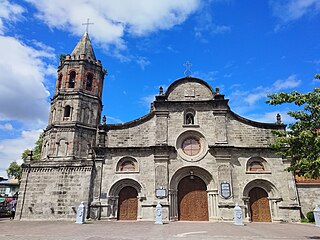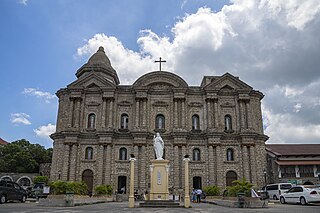
Lobo, officially the Municipality of Lobo, is a municipality in the province of Batangas, Philippines. According to the 2020 census, it has a population of 40,736 people.

Rosario, officially the Municipality of Rosario, is a municipality in the province of Batangas, Philippines. According to the 2020 census, it has a population of 128,352 people.

The Archdiocese of Lipa is a Latin Church ecclesiastical territory or archdiocese of the Catholic Church in the Philippines comprising the civil province of Batangas. Its cathedral is the Metropolitan Cathedral of St. Sebastian located in Lipa, Batangas. First created on April 10, 1910 from the Archdiocese of Manila, the diocese was elevated into its present status on June 20, 1972. Today, the Archdiocese of Lipa's ecclesiastical province covers Batangas and the suffragan territories in the civil provinces of Quezon, Marinduque, and Aurora. The archdiocese itself is divided into 14 vicariates forane further comprising a total of 65 parishes.

Our Lady of Mount Carmel Parish, also known as Barásoain Church is a Roman Catholic church built in 1888 in Malolos, Bulacan, Philippines. It is under the jurisdiction of the Diocese of Malolos and is about 42 kilometers (26 mi) from Manila. Having earned the title as the "Cradle of Democracy in the East, the most important religious building in the Philippines", and the site of the First Philippine Republic, the church is proverbial for its historical importance among Filipinos.

The Minor Basilica and Parish of Saint Martin of Tours, commonly known as Taal Basilica, is a minor basilica in the town of Taal, Batangas, within the Archdiocese of Lipa. It is considered to be the largest church building in the Philippines and in Asia, standing 88.6 meters (291 ft) long and 48 meters (157 ft) wide. Martin of Tours is the patron saint of Taal, whose feast is celebrated every November 11.
Local elections were held in the province of Batangas on May 13, 2013 as part of the 2013 general election. Voters will select candidates for all local positions: a town mayor, vice mayor and town councilors, as well as members of the Sangguniang Panlalawigan, the vice-governor, governor and representatives for the four districts of Batangas.

Immaculate Conception Parish Church, commonly known as Balayan Church, is a Roman Catholic parish church in the town of Balayan, Batangas in the Philippines, under the jurisdiction of the Archdiocese of Lipa. The church is listed as a National Cultural Treasure as its construction was supervised by Filipino Seculars during the Spanish Colonial Period.

The Archdiocesan Shrine of Our Lady of Caysasay is a coral-hewn Roman Catholic chapel in Barrio Caysasay in Taal, Batangas, belonging to the Archdiocese of Lipa in the Philippines. It was built in 1639 by Fr. Alonso Rodriguez to replace a temporary structure built in 1611. The church is home to Our Lady of Caysasay whose feast day is celebrated every December 8.

The Minor Basilica and Parish of the Immaculate Conception, alternatively known as the Archdiocesan Shrine of Santo Niño de Batangan, is a minor basilica in Batangas City, Philippines. It is under the jurisdiction of the Archdiocese of Lipa. It was made an independent parish in 1614 under the advocation of the Immaculate Conception. It is one of the oldest churches in Batangas.

San Carlos Borromeo Parish Church, commonly known as Mahatao Church, is a Roman Catholic church located in Mahatao, Batan Island, Batanes, Philippines. It is under the jurisdiction of the Territorial Prelature of Batanes. The church's titular is Saint Charles Borromeo whose feast is celebrated every November 4. Its beauty and excellent state of preservation made it a National Cultural Treasure by the National Museum of the Philippines on July 31, 2001.

The Archdiocesan Shrine and Parish of Saint Joseph the Patriarch, also known as Saint Joseph the Patriarch Church, is a Roman Catholic church located in the town center of San Jose, Batangas, in the Philippines. It is under the jurisdiction of the Archdiocese of Lipa. The church is known for being one of the parishes that Fr. Manuel Blanco OSA, who authored the Flora de Filipinas, administered.

San Pedro Apostol Parish Church, commonly known as Loboc Church and alternatively as the Diocesan Shrine of Our Lady of Guadalupe in Extremadura, is a Roman Catholic church in the municipality of Loboc, Bohol, Philippines, within the jurisdiction of the Diocese of Tagbilaran.

Santa Monica Parish Church, commonly known as the Alburquerque Church, is a Roman Catholic church in the municipality of Alburquerque, Bohol, Philippines. It is under the jurisdiction of the Diocese of Tagbilaran. The church was declared as an Important Cultural Property by the National Museum of the Philippines in 2013.

The Diocesan Shrine and Parish of San Miguel Arcangel, is a 19th-century, Baroque Roman Catholic church located along De Leon St., Brgy. Poblacion, San Miguel, Bulacan, Philippines. The parish church, with Saint Michael, the Archangel as patron saint, is under the jurisdiction of the Diocese of Malolos.

The Parish Church of Saint Lawrence of Rome, Deacon and Martyr, commonly known as the Balagtas Church, is an 18th-century Baroque Roman Catholic parish church in the Municipality of Balagtas in the Philippines, dedicated to Saint Lawrence, one of the most venerated Roman martyrs, celebrated for his Christian valor.

Immaculate Conception Parish Church, commonly known as Bauan Church, is a Neo-classical church located in Bauan, Batangas, in the Philippines. It is under the jurisdiction of the Archdiocese of Lipa. The church is the third and final relocation site of Bauan after its transfer from the shores of Bombon Lake, to Durugto, to Lonal, and finally to its present site near the shores of Batangas Bay. The church is also one of the parishes administered by Fr. Manuel Blanco, who perfected the art of dyeing by means of plants in Bauan.

The Archdiocesan Shrine and Parish of Saint James the Greater, commonly known as Ibaan Church, is a Roman Catholic shrine and parish church in the municipality of Ibaan, Batangas in the Philippines. Known for its Easter traditions of Bati and Dagit, the church was founded in 1817 while the current structure was built from 1853 to 1869.

Saint Michael the Archangel Parish Church, commonly known as Bacnotan Church, is a Roman Catholic church located in Bacnotan, La Union, Philippines. Dedicated to Saint Michael the Archangel, it is under the jurisdiction of the Diocese of San Fernando de La Union.

The Parish and National Shrine of Saint Padre Pio, commonly known as Padre Pio Shrine, is a Roman Catholic parish church and pilgrimage site situated along Governor Antonio Carpio Avenue in Barangay San Pedro, Santo Tomas, Batangas, Philippines. It is consecrated to the Italian Saint Pio of Pietrelcina.

San Juan Nepomuceno Parish Church is a Roman Catholic church in San Juan, Batangas, Philippines. It is under the jurisdiction of the Archdiocese of Lipa. Located at Padre Burgos Street in Poblacion, adjacent to three schools: Batangas Eastern Colleges, Joseph Marello Institute, and San Juan Elementary School, this is the second church of San Juan after the old church ruins, located in Pinagbayanan, which was destroyed by floods in 1883.




























